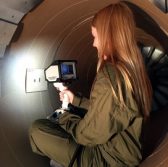 The Air Force Research Laboratory and Intelligent Automation Inc. have developed and tested a sensor that works to automate the inspection of aircraft inlet and exhaust damage under a $4 million contract.
The Air Force Research Laboratory and Intelligent Automation Inc. have developed and tested a sensor that works to automate the inspection of aircraft inlet and exhaust damage under a $4 million contract.
Wright-Patterson Air Force Base said Wednesday the Auto-Scan: Inlet and Exhaust Damage Registration Sensor is designed to characterize, localize and register aircraft damage then transfer the information to an internal health assessment system.
Juan Calzada, AFRL project engineer, said the tool aims to aid maintainers and optimize the time aircraft spend out of service.
WPAFB added AFRL is currently transitioning Auto-Scan for field deployment as part of a $2.5 million Rapid Innovation Fund award from the Defense Department.
AFRL’s materials and manufacturing directorate and IAI created Auto-Scan under a Small Business Innovative Research contract.
IAI offers research and development services in the areas of air traffic management, big data and social media analytics, control and signal processing, cybersecurity, education and training technologies, health technologies and others.




